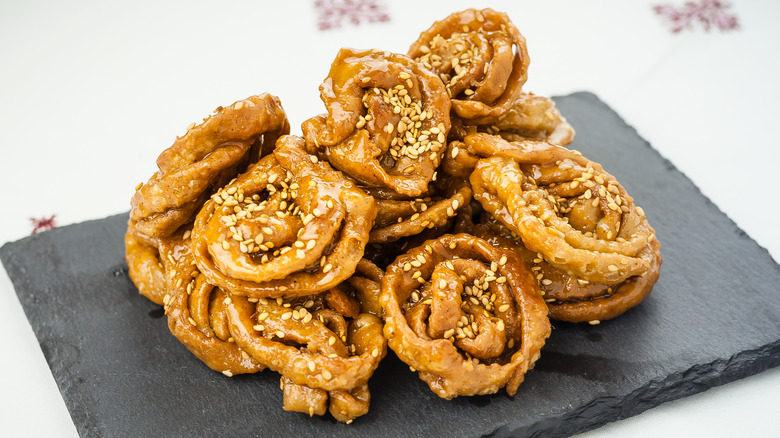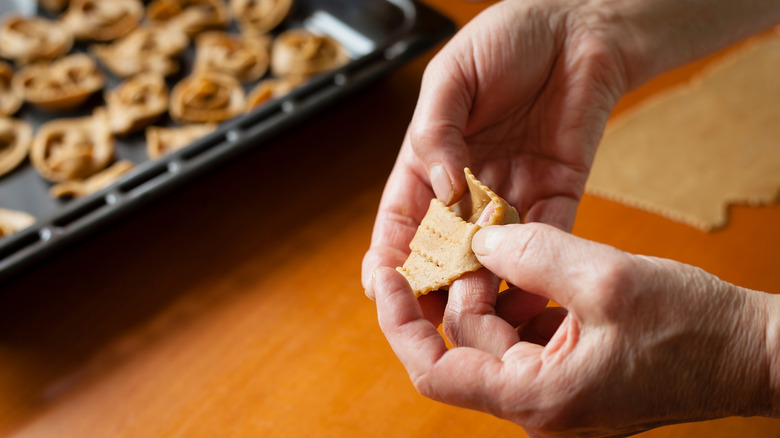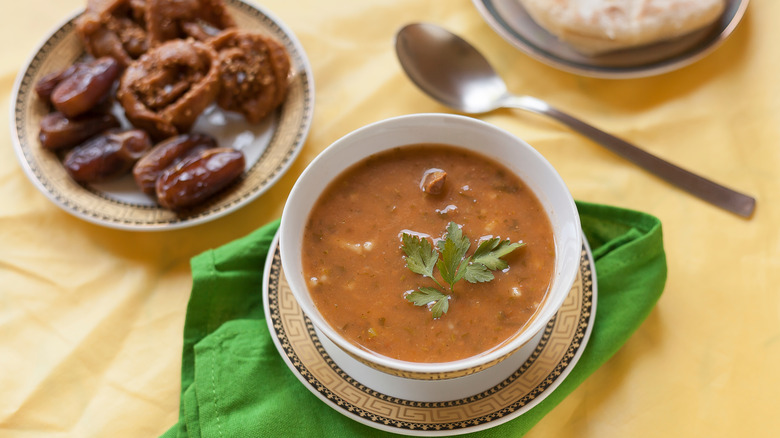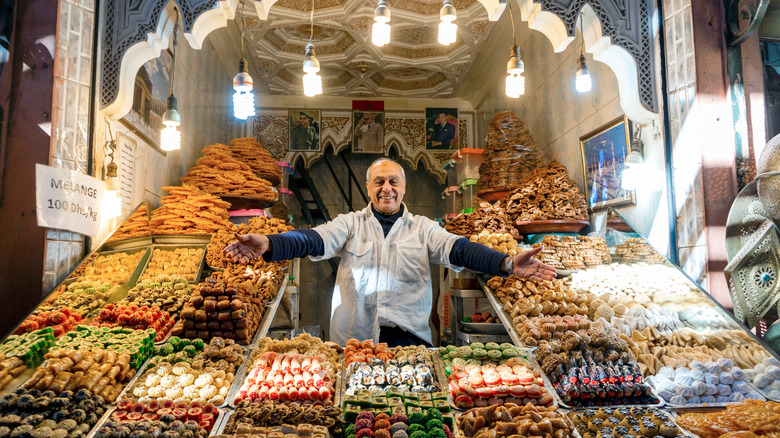The Moroccan Sesame Cookies That Are Well Worth Their Prep Time
The rose-shaped cookies famous to Morocco are an act of love — something that Moroccan homemakers traditionally dedicated hours on end to, delicately forming each one between their own fingers (per The Spruce Eats). Commonly referred to as chebakia, also spelled chebbakia, or shebakia, these cookies are made from scratch and formed one by one, before being fried and dropped into a honey glaze. There, they absorb all of the sweet flavors and aromas that Moroccan cuisine is known for, including cinnamon, saffron, turmeric, and orange blossom, depending on where and whom you get them from.
With enough time in the honey glaze, the cookies develop a deep, glossy color at which point they're removed and sprinkled with toasted sesame seeds before being left to cool. Traditionally served during Ramadan and special occasions, chebakia are known far and wide — but Morocco is its birthplace. Whether you're in Rabat, a city in which the cookies are known as "mkhrareka," or Fez, where they're called "gryoch" (via Patisserie Gato), the hand-formed, sesame-coated sweets are a proud emblem of Moroccan culture, and they'll know exactly what you're asking for.
Ingredients and how it's made
Whether it's lamb shanks or couscous, Moroccan cuisine is notorious for being time-consuming, and chebakia is no exception. That's because, while beautiful, the flower-shaped design that these cookies dawn is extremely intricate. Like all cookies, chebakia begins by getting the dough just right. After mixing the flour, ground sesame seeds, and other dry ingredients with spices like cinnamon, ground anise, saffron, and turmeric, the dough is mixed until it's both firm and pliable before being cut into small rectangles and shaped by hand, one by one (via The Spruce Eats).
Once the shaping process is done, the frying process can commence. While the oil heats up, the honey glaze is prepared by bringing honey to a boil mixed with orange blossom water or lemon and cinnamon (per Patisserie Gato). When the glaze is done, and your oil is hot, the cookies get fried in batches for a few minutes at a time and then immediately transferred into the honey glaze. They'll then sit in the glaze for a few minutes, depending on preference. According to The Spruce Eats, the longer that they're left in the glaze, the sweeter and softer they'll be. After that, each cookie is put in a colander so the extra glaze can drain, and they're then sprinkled with sesame seeds before they're left to cool.
How it's served
Traditionally served during Ramadan Iftar — the meals shared before sunrise or after sunset to break fast (per UN Refugee Agency) — chebakia are often paired with other foods that are popular during Ramadan. In Morocco, this almost always means you'll be enjoying your chebakia with a hot serving of harira. Harira is a traditional Moroccan soup made from a blend of Maghreb spices like cumin and turmeric, vegetables, chickpeas, and meat (via Taste of Maroc). For many Muslim Moroccans, a Ramadan meal isn't complete without harira. Seeing as it's almost always served with chebakia, the same can be said for the famous rose-shaped cookies too.
While traditionally served with harira on special occasions like weddings and Ramadan, Patisserie Gato claims that the tradition is becoming rarer. It seems that chebakia are so good, people have gotten into the habit of eating them all year round, even outside of the Ramadan season. They're particularly enjoyed for breakfast with a cup of coffee, or along with other pastries and snacks during afternoon tea. Whether you want to save chebakia for Ramadan, or you need a few of those cookies to just get your day started, chebakia comes without limits. Enjoy them at any time of the day, morning or night, when your sweet tooth has the glossy, sesame-coated cookies calling your name.
Where to buy chebakia
Unfortunately, you won't find chebakia at your average grocery store bakery — but it's much better to support your friendly, neighborhood pastry shops when it comes to baked goods anyways. If you live in New York City, Meska Sweets is a fabulous Moroccan pastry shop that serves chebakia all year round. But, if you don't have a Moroccan bakery in your area, you're also likely to find them at other Mediterranean and Middle Eastern cafés. It also doesn't hurt to look into the dessert menus of any Moroccan and Middle Eastern restaurants near you, as there's always a chance that chebakia could be an option.
If you're not having any luck finding chebakia locally, fear not. Before you commit to buying the ingredients and taking on the challenge of shaping each cookie by hand, you should know that chebakia has a long shelf life. The Spruce Eats claims that, when stored in an airtight container at room temperature, the cookies will last for a month. If they're frozen, they'll last 4-5 months. If you don't have any Moroccan pastry shops nearby, you can easily order them online. For this, The Moroccan Bakery or New York's Meska Sweets are good, authentically made options.



